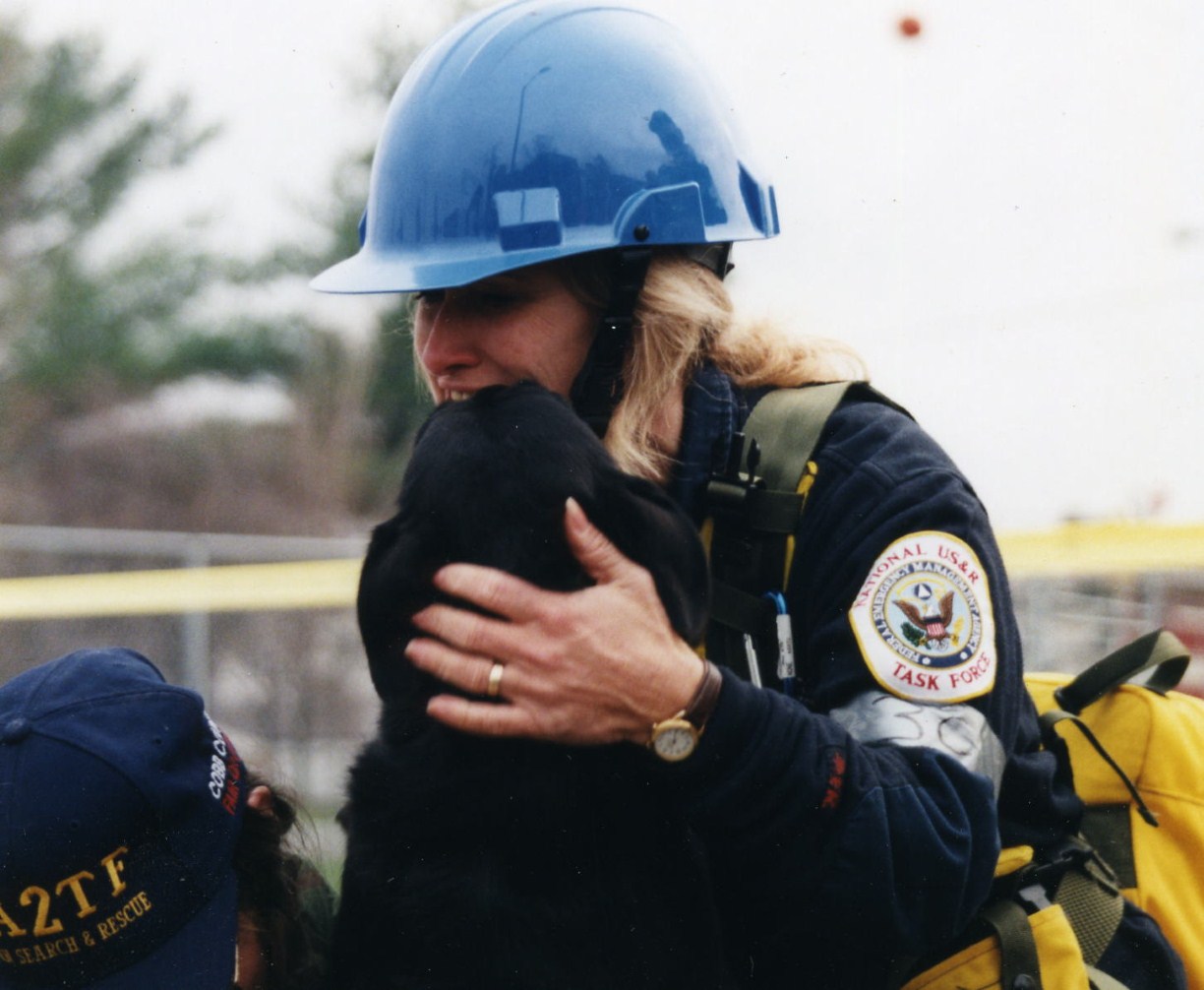Note: I was asked to do a seminar for Dogs East – a very prestigious search team based in Virginia. I was sent videos of searches and discovered a major problem – false positives. I was aware of the Navy program that I mention in the article, but the work they did was classified secret. They couldn’t talk to me. So I recreated the process. A few years later the head of the Navy Marine Mammal group in San Diego called me to help him tweak their program. Ironically, I couldn’t help him because he couldn’t tell me what they actually do. This same problem with “false positives” is an inherent weakness of any detection dog – for search, explosives, drugs or any other scent identification task.
If you call Theresa McPherson’s answering machine you will hear a message that mentions her two Labrador Retrievers, Magoo and Bama. The message says: “Magoo can’t take your call, right now — because Magoo can’t talk. Bama can’t take your call right now, either, because Bama can’t come to the phone.” If you think this message implies that Magoo can’t talk, but  Bama can, you may be right.
Bama can, you may be right.
Before you start imagining that Bama speaks some form of English, you should know that she does not actually pronounce words. Bama’s form of speech is a combination of normal dog sounds and sign language. She communicates by changing her location, laying down and barking, or grabbing a stick with her mouth. To understand why this type of “talking” behavior is important, it is necessary to know that Bama is an experienced search and rescue dog.
Search and rescue work is a complex game of hide and seek. The object of the search could be a lost hiker, a mentally impaired person or the body of a murder victim. In a traditional s earch routine, a dog is told to “go find” and is expected to actively seek any human scent in the designated area. While many dogs and handlers remain in contact as they search an area, the best dogs work far ahead of their handlers. If the dog finds someone, it is expected to return to the handler and give an “indication”; a specific behavior that means, “I found something.” Some dogs indicate a find by returning to their handler and barking. Other dogs are taught to boisterously leap on their handler. When the dog indicates, the handler commands “show me!” and the dog retraces its steps to the victim. Once the victim is found, the dog is usually lavished with praise and allowed to play with a favorite toy or ball as a reinforcement. Most search dogs love the game and work diligently for the reward at the end of the sequence.
earch routine, a dog is told to “go find” and is expected to actively seek any human scent in the designated area. While many dogs and handlers remain in contact as they search an area, the best dogs work far ahead of their handlers. If the dog finds someone, it is expected to return to the handler and give an “indication”; a specific behavior that means, “I found something.” Some dogs indicate a find by returning to their handler and barking. Other dogs are taught to boisterously leap on their handler. When the dog indicates, the handler commands “show me!” and the dog retraces its steps to the victim. Once the victim is found, the dog is usually lavished with praise and allowed to play with a favorite toy or ball as a reinforcement. Most search dogs love the game and work diligently for the reward at the end of the sequence.
One consistent problem with traditional search practices is that dogs and handlers must sometimes for go for long periods without finding anyone. After several hours of difficult searching, a tired and frustrated dog may come to an obvious conclusion — the quickest way to get reinforced is to return to the handler and bark. In other words, the dog can learn to fib.
There are few things more frustrating to a search group than a dog that will offer “false positives”. The cornerstone of a search team is the handler’s ability to trust the dog’s reactions. In some situations the accuracy of the animal may mean the difference between life and death. An untrustworthy dog may convince searchers to invest vital manpower looking in the wrong place.
The solution to this dilemma comes from a surprising source. The US Navy has used marine mammals for many years to locate sunken missiles, ships and aircraft. Navy trainers solved the problem of false positives by teaching their animals to periodically return to their handler and report on the progress of the search. While the process is relatively unknown among dog trainers, the Navy has perfected this method over the last 40 years. Bama’s report training was a recreation of this same technique.
To get the process started, Theresa modified Bama’s basic search behaviors. Since Bama already knew how to stand and bark to indicate that she had found someone, Theresa needed a new signal. If Bama searched but did not find someone, the dog was taught to grab a short wooden stick that Theresa hung from her belt. This allowed Bama to report on what she had found and what she had not.
In the early stages of training, Theresa used two identical army surplus ammunition cans. One of them contained human scent and one did not. One ammo-can would be placed in the search area and Bama would be allowed to investigate. If she detected human scent, her regular search behavior would be triggered and she would return to Theresa and bark. If the un scented can was in the search zone, Bama would periodically called to return and then asked if she had found anything. If she grabbed the stick hanging from Theresa’s belt, she could still be reinforced for a correct report and a good search. If she returned and barked, she would not be reinforced and would be asked to try again. Since Theresa always knew if there was something to find in the search area, it allowed her to give Bama a reward for reporting correctly — even if there was nothing to find. Now, when Bama was frustrated by a long search, the dog could return to her handler and say “I haven’t found anything”. The dog was no longer tempted to fib in order to be reinforced.
scented can was in the search zone, Bama would periodically called to return and then asked if she had found anything. If she grabbed the stick hanging from Theresa’s belt, she could still be reinforced for a correct report and a good search. If she returned and barked, she would not be reinforced and would be asked to try again. Since Theresa always knew if there was something to find in the search area, it allowed her to give Bama a reward for reporting correctly — even if there was nothing to find. Now, when Bama was frustrated by a long search, the dog could return to her handler and say “I haven’t found anything”. The dog was no longer tempted to fib in order to be reinforced.
One of the first benefits of Bama’s new ability to “talk” was that her false positives dropped to almost zero. The dog was consistently able to either find a target and report it, or return to her handler and report that she had found nothing. Since she was reinforced for reporting correctly, whether or not she had found anything, she was capable of longer searches without being frustrated by consistent failure.
Once Bama’s accuracy with two signals was perfected, Theresa broadened the dog’s vocabulary. A macabre aspect of searching a disaster scene is the necessity to differentiate between live victims and those who are already dead. Search crews need to focus their resources on those victims who may be saved. Most “disaster dogs” are trained to stand and bark over a live victim. If the person is no longer alive, the dog returns to the handler and lays down, silently.
Once, during a difficult training exercise, Bama was sent into a building that had only an artificial scent of someone who was dead. Bama returned after a few minutes and did something startling. She lay down in front of Theresa and barked. This was obviously a mistake, since the combination of the two signals would translate as “I found someone who is dead, and I found someone who is alive.” This error was baffling until Theresa looked at the spot where the “victim” had been hidden. Next to the spot was an open window. Several other search teams were standing by the window, chatting. When Bama found the scent of the victim, she had also smelled the live people outside the window. Her decision was to return to Theresa and offer an accurate report — “I found both things!” Not only did Bama tell Theresa what she had found, she did it by creating a compound word.
While most of us speculate on our dogs’ intelligence, few people ever explore the real boundaries of their dog’s behavior. Real life situations such as search and rescue can often shed light on an animal’s capacity to think. If you ask Theresa, she will probably tell you that she is still discovering new facets of Bama’s mental abilities. In the end, Bama will probably have the last word on the subject.
